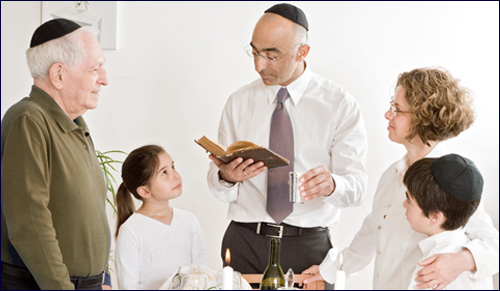Start With A Glow
The mitzvah to light candles before the start of Shabbat is an important one. It fulfills the mitzvot of both kavod and oneg Shabbat.1 The added glow also fills the home with a peaceful atmosphere and increases our joy and pleasure.2 It is so important to have candles at the Shabbat table that the Sages state that one who does not have enough money to buy a candle should go door to door collecting charity in order to buy it!3
For The Women
Although anyone can light the Shabbat candles, it is primarily considered the woman’s mitzvah, since she is usually in charge of running the home.4 Another reason is that lighting candles is a tikkun (spiritual repair) for the sin of Chava, who darkened the world when she caused Adam to eat from the Eitz Hadaat (tree of knowledge). Now, every week the Jewish woman has the opportunity to bring light and peace into her home as she lovingly lights her Shabbat candles.5
The usual time to light is 18 minutes before sunset, but some communities, like Yerushalayim, light even earlier.6 The earliest you can light is at plag haminchah, which is usually about an hour and a few minutes before sunset.7 The latest time is just before the sun sets. Once the sun sets, Shabbat has begun, and lighting a fire is forbidden, even if you haven’t yet lit your candles.
The blessing for lighting Shabbat candles is, “Lehadlik ner shel Shabbat.” Ashkenazic women first light the candles and then cover their eyes and say the blessing. Once that is said, Shabbat has started for them, and lighting a flame would be forbidden.8 Most Sephardic women first say the blessing, and then light, because they don’t consider the blessing to cause them to automatically accept Shabbat.9
The Candle’s Light
The Gemara specifies a specific blessing to those that are careful with the mitzvah of neirot. It promises that they will merit children who are Talmidei Chachamim (Torah scholars).10 Why does this mitzvah carry such a powerful reward? The Chachamim explain that this is based on the pasuk in Mishlei:
“Ki ner mitzvah v’Torah ohr”
A mitzvah is a candle, and Torah is light
Mishlei 6:32
When we light the ner, the Shabbat candle, we will merit the light of Torah. After a woman does her special mitzvah of lighting candles, it is an especially auspicious time for her to daven that Hashem grant her children who will light up the world with Torah.11
Rabbeinu Bechaya explains that a Jewish mother is the very reason that Torah has a future as it is she who develops her children’s love of Torah from a young age and encourages them to learn. Therefore, after she does her unique mitzvah which provides physical light, it is a powerful moment to daven that her children merit to spread the spiritual light of Hashem’s Torah throughout the world.12
The Light Of The Menorah
This deep connection between candles and Torah also appears in the Beit Hamikdash (Holy Temple). The Menorah was a lot more than physical light. It represented the illuminating wisdom of Torah.13 Lighting Shabbat candles brings the glow of the menorah and all it represents into our homes. Some have a minhag (tradition) to specifically place the candles to the right of the table, just as the menorah in the Beit Hamikdash stood to the side of the shulchan (table).14
In fact, the Kedushat Levi teaches that when a woman lights Shabbat candles, it is as beloved to Hashem as when Aharon the Kohen Gadol (high priest) lit the menorah in the Mishkan (tabernacle)!15 He goes further to explain that it was in the merit of the Jewish people’s devotion to the mitzvah of lighting Shabbat candles that they merited the miracles of Chanukah.16
The tremendous importance of lighting Shabbat candles plays out in practical halachah (Jewish law), too. If a person can only afford one candle, either for Shabbat or Chanukah, the halachah is that the Shabbat candle takes priority!17 This is because when we light those flames, we are doing more than marking the start of Shabbat. We are creating a peaceful atmosphere where Torah can shine, and planting the seeds of Torah for the next generation.
Soul On Fire!
Shlomo Hamelech tells us in Mishlei (Proverbs), “Ner Hashem nishmat adam – The soul of a person is the lamp of Hashem”.18 This deep truth about the candle and flame helps us understand how our body and soul work together.
Striving for More
Look at a flame. It dances upward, as if trying to break free and rise to the sky, but it stays attached to the wick. That’s like our soul. It wants to connect deeply with Hashem, to rise higher and higher. But at the same time, it’s attached to this earthly world for a reason: to live here and do mitzvot, bringing Hashem’s light into this world.
Oil, Wick and Flame
A lamp, or candle, needs three things: a wick, oil (or wax) and a flame. The wick is like our body, physical and grounded. The oil is the Torah and mitzvot that fuel us, and the flame is our soul, lit up when we connect our body with Hashem’s mitzvot. Without Torah and mitzvot, the wick (our life) can’t stay lit. And without a physical body to perform those mitzvot, the Divine oil can’t become light in this world. Every mitzvah adds oil to our flame. Every time we do Hashem’s will, we burn brighter, drawing close to Hashem and making the world a more beautiful place.19
Excerpted from Oorah’s Torah Nuggets
Candles – Sources:
1 Rambam hilchos shabbos – oneg 5:1, kavod 30:5
2 Shulchan Aruch OC 263:2, and Pri Megadim: ‘במשבצות זהב לאו”ח סימן רס”ד ס”ק א2 Shulchan Aruch 263:2
3 Shulchan Aruch, Orach Chaim 263:3
4 Midrash Rabbah, Bereishis 17:8
5 Shulchan Aruch, Orach Chaim 261:2
6 Shulchan Aruch Orach Chaim 261:4
7 Shulchan Aruch, Orach Chaim 263:5; Mishnah Berurah 263:27
8 Kaf HaChayim 263:41; Yalkut Yosef 263:38
9 Shabbos 23b
10 Mishlei 6:23
11 Mishna berura 263:2
12 Rabbeinu Bachya, Shemos 19:3
13 Bava Batra 25b
14 Kaf Ha-chayim
15 Kedushas Levi, Chanukah §3
16 Kedushas Levi, ibid
17 Shulchan Aruch, Orach Chaim 678:1
18 Mishlei 20:27
19 Rabbi Schneur Zalman of Liadi


